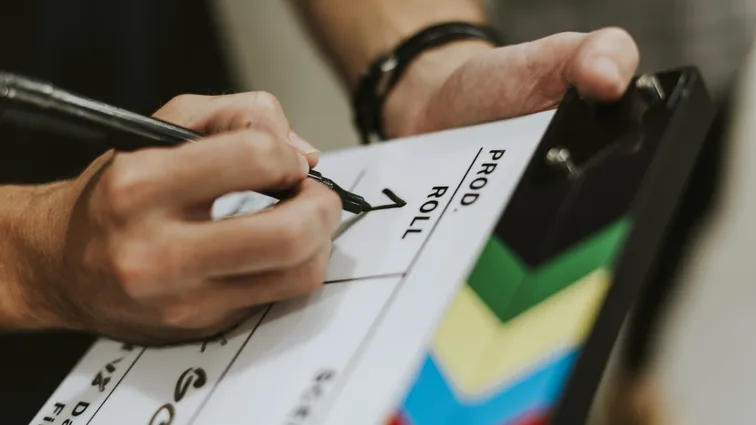What legal steps must a producer take before the first clapperboard, to ensure their audiovisual work can see the light of day? Without solid legal foundations – from securing rights for individual shots to contractual relationships with each crew member – production can quickly turn into a nightmare. Read on to find out what you need to look out for to ensure your project doesn’t fail before it even starts.
In the first article of our series for filmmakers, we focused on the development phase, addressing fundamental questions related to the creation of audiovisual works – particularly films, series, music videos, and commercials. In the second part of our series, we turn our attention to the subsequent production phase and the key legal issues associated with it.
The production of an audiovisual work begins with the first take and ends with the final shot. In order for everything to run smoothly, it is necessary to address not only the filming itself but also the legal aspects. So, what should a producer secure before the first take?
Secure all rights
From a legal perspective, films, series, documentaries, and even commercials are considered audiovisual works protected by copyright. This protection extends to the audiovisual work as a whole as well as to its individual parts, such as daily and behind-the-scenes footage, music, and works captured in the shots (e.g., images, logos, posters, and also photographs from the set). It is therefore essential for the successful realization of a production to secure and clear all rights to the created work.
Intellectual property rights are cleared by concluding contracts with all individuals whose performances or likenesses are recorded (i.e., actors and extras) or who contribute creatively to the work, such as directors, cinematographers, scriptwriters, artists, sound engineers, lighting technicians, and designers. If the work includes pre-existing protected materials (music, videos, images, etc.), it is necessary to conclude license agreements with the respective rights holders (typically collective management organisations, artists, and studios) to allow the use of these materials in the new work.
Sign here, please
In practice, we often encounter situations where some key individuals do not have a written contract with the producer and only receive payment for their services. This is highly problematic because, without a written contract, the scope of rights to the given work granted to the producer may not be clear. For instance, if a dispute arises between the producer and the artist, it could be risky for the producer to use that person’s contributions in the work, potentially leading to significant complications in the production process.
From a legal perspective, this issue can be resolved quite simply – every person whose work appears in the production or who influences its final form should sign a contract with the producer containing necessary provisions regarding IP rights. For extras and less critical crew members, we recommend, as best practice, having pre-printed standard license agreements/releases on set for the given production. These can be provided to the relevant individuals for signing at any time.
Exclusive producer takes all
Another important aspect of production is the number of parties involved in the producer role. Generally, the most straightforward production process for an audiovisual work is exclusive or sole production. In this case, a single producer handles the entire production and usually its financing (e.g., through sponsors and support/incentives from film funds), and holds all rights to the final work.
The main advantage of this model is that all profits from the commercialisation of the work (excluding distribution fees) belong to the sole producer. On the other hand, the producer also bears the risk of commercial failure and potential loss. This type of production is therefore more common in Hollywood blockbusters or successful series, where studios or platforms expect high commercial returns, as well as for independent/low-budget films or documentaries , where creative control and ownership are often prioritized.
Not all (co-)producers are the same
Given the specifics of exclusive production, a more common method for creating audiovisual works is co-production, where multiple parties are involved in the production process.
The reason for this approach is simple – producing audiovisual works is quite expensive, and the production company often cannot or does not want to cover the entire budget alone. Co-production allows the costs and commercial risks associated with production to be shared among several parties.
Unlike exclusive production, where contractual relationships with partners primarily focus on promotional strategies or sponsorship, co-production requires a detailed contractual arrangement outlining the rights and obligations of each co-producer based on the nature and value of their contributions – typically financial investments, in-kind contributions, provision of rights,services, and more. The co-production contribution determines each co-producer’s share in the audiovisual work and their level of involvement, often including exclusive distribution rights in specific territories or opportunities for creative participation in the production process.
Regardless of the type of production, we strongly recommend thoroughly documenting all agreements between parties involved in creating the audiovisual work, as unwritten agreements can be difficult to enforce in practice.
Conclusion
The production phase is a pivotal stage in creating audiovisual works. It’s crucial not only to concentrate on the production itself but also to adequately address the legal aspects of contractual relationships with key partners and individuals.
Our specialised film and television team is highly experienced in audiovisual production, working extensively on both local and international projects. With our deep experience in this field, we are well-equipped to support you. Please don’t hesitate to reach out if you require any assistance.








